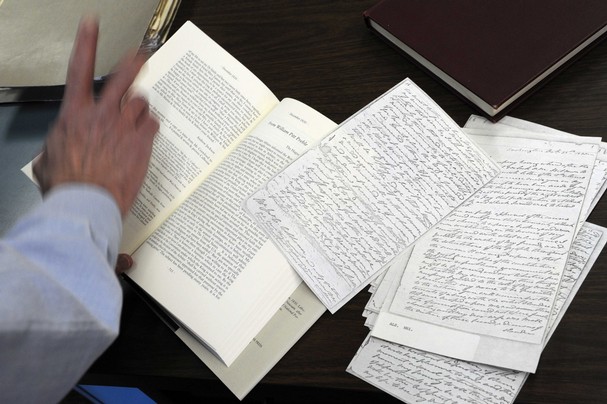The original version of this story ran in Tennessee Today. You can visit the website at: http://tntoday.utk.edu/2013/12/09/ninth-volume-jackson-papers/
A woman with a dubious reputation. Presidential cabinet members at each other’s throats. A president with a conspiracy theory.
It’s not a fictional story of political intrigue. It’s real-life drama—detailed through the correspondence chronicled in the ninth volume of The Papers of Andrew Jackson, recently published by the University of Tennessee Press.
This latest tome, which focuses on 1831, was compiled by Daniel Feller, editor and director of the Jackson papers and a professor of history at UT. Associate editors were Laura-Eve Moss and Thomas Coens.
The Jackson project is hosted by the UT History Department and sustained by two federal agencies, the National Endowment for the Humanities and the National Historical Publications and Records Commission. Last year the project won a $300,000 NEH grant—the project’s largest grant ever—to complete this volume.
More than any previous entry in the series, this volume portrays the “unvarnished Jackson,” Feller said.
“This is the most lurid year in Jackson’s presidency and maybe any presidency,” he said. “He is more paranoid, more unbalanced than we’ve ever seen him before—and at the same time more shrewd, more calculating, more politically savvy. Jackson is a protean figure in American history. He’s a subject of adulation and condemnation. He’s right up there with the most controversial presidents we’ve had.”
Correspondence included in the volume reveals the dysfunction in Jackson’s presidential cabinet. It tells the story of the infamous “Petticoat Affair.”
Jackson’s secretary of war, John Eaton, was married to Margaret “Peggy” O’Neale Timberlake—a woman who was disliked by most of Jackson’s other cabinet members and their wives.
“They thought she was a slut,” Feller says bluntly.
The festering situation led Eaton and Secretary of State Martin Van Buren to tender their resignations—and that prompted Jackson to demand that the rest of his cabinet resign too.
In June 1831, with the situation still very raw, a Washington newspaper published an exposé blaming the cabinet breakup on Mrs. Eaton.
The publicity nearly prompted a duel between two cabinet members—and caused one of them to pen a letter to Jackson charging that a gang of high administration officers had tried to kill him.
The volume also points to the animosity between Jackson and his vice president, John C. Calhoun. It includes correspondence about Jackson’s fury over an incident that had happened years earlier, when he was an army general and Calhoun was secretary of war.
Jackson had learned that Calhoun had wanted him reprimanded for attacking Spanish forts in Florida. Then-president James Monroe had decided to defend Jackson’s actions—and Calhoun, despite his thoughts on the matter, had agreed to publicly back Jackson.
“In 1830, Jackson found it convenient to reopen this old wound,” Feller said. “Jackson went to great lengths to accuse Calhoun of conspiring against him.
“It was clear to Calhoun that Jackson was trying to drive a wedge that would sabotage his own presidential aspirations,” Feller said. “Jackson got to the point where he blamed Calhoun for everything that went wrong in his administration. He said some of the nastiest things a president has ever said about his vice president, even comparing him to Satan.”
The volume also includes documents revealing public hysteria regarding the Nat Turner slave rebellion, documents detailing Jackson’s infamous Indian removal policy, revelations that Jackson was anonymously penning newspaper editorials supporting his own policies, and letters that tell the story behind Jackson’s hatred of Davy Crockett.
Feller said the new volume incorporates many documents never seen before.
In addition to printing documents housed in the National Archives and various libraries around the nation, “we found letters that are in private hands—owned by descendants of historical figures who had never shown them to anyone until now.”
